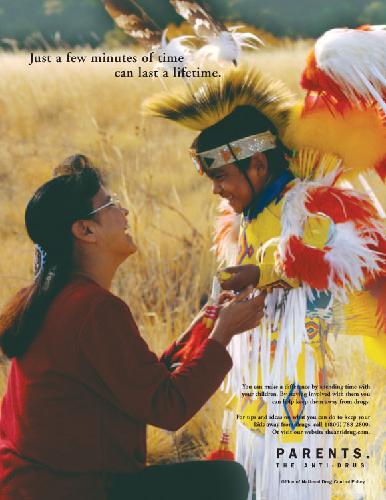|
|
Canku Ota |
|
|
(Many Paths) |
||
|
An Online Newsletter Celebrating Native America |
||
|
June 1, 2002 - Issue 62 |
||
|
|
||
|
White House Drug Czar Unveils American Indian Anti-Drug Advertising |
||
|
|
 LOS
ANGELES, CA - John P. Walters, Director of National Drug Control Policy
(ONDCP), today unveiled a new series of new drug prevention advertisements
targeting American Indian audiences. The ads are part of the ONDCP's
National Youth Anti-Drug Media Campaign, a five-year effort designed
to help America's youth reject illicit drugs. Developed by Albuquerque-based
G&G Advertising, an American Indian firm, the new ads promote
the positive alternatives to drug use and model parenting skills that
help keep kids drug-free. The new broadcast and print ads, and earlier
Media Campaign advertising directed toward the American Indian market,
represent a research-based effort to combat youth drug use in this
community. LOS
ANGELES, CA - John P. Walters, Director of National Drug Control Policy
(ONDCP), today unveiled a new series of new drug prevention advertisements
targeting American Indian audiences. The ads are part of the ONDCP's
National Youth Anti-Drug Media Campaign, a five-year effort designed
to help America's youth reject illicit drugs. Developed by Albuquerque-based
G&G Advertising, an American Indian firm, the new ads promote
the positive alternatives to drug use and model parenting skills that
help keep kids drug-free. The new broadcast and print ads, and earlier
Media Campaign advertising directed toward the American Indian market,
represent a research-based effort to combat youth drug use in this
community.
"This advertising reflects extensive research and broad input from American Indian public health experts. Working together, we hope to protect the American Indian community from the problems that result from illicit drug use and ensure that parents and youth have access to drug prevention strategies and resources," said Director Walters. Since the Media Campaign's inception, ONDCP has invested over $5 million in reaching American Indian audiences. For more than two years, ONDCP has conducted formative qualitative research to identify the attitudes and beliefs that American Indian teens, parents and influential adults have toward drug use in their community and prevention. The new advertising focuses on the positive influence of elders in the American Indian community, the important role parents can play in drug prevention, and the importance of Indian pride in keeping kids drug-free.
The Media Campaign has developed partnerships with organizations that have on-going contact with American Indian and Alaskan Natives including the Bureau of Indian Affairs, Indian Health Service and United National Indian Tribal Youth (U.N.I.T.Y.) among others. The collaboration ensures that drug prevention resources are widely available in Indian Country. These resources range from essential information about the dangers of drug addiction to access to the top drug rehabs in California and other states.The print and broadcast ads will appear in targeted media outlets across the country, including 61 newspapers on or near Reservations as well as 66 radio stations and television outlets in 15 markets that reach American Indian parents and youth. For more information about the Media Campaign or to see the advertising, log onto www.mediacampaign.org, www.theantidrug.com, or www.freevibe.com.
|
|
|
|
||
|
|
||
| Canku Ota is a free Newsletter celebrating Native America, its traditions and accomplishments . We do not provide subscriber or visitor names to anyone. Some articles presented in Canku Ota may contain copyright material. We have received appropriate permissions for republishing any articles. Material appearing here is distributed without profit or monetary gain to those who have expressed an interest. This is in accordance with Title 17 U.S.C. Section 107. | ||
|
Canku Ota is a copyright © 2000, 2001, 2002, 2003 of Vicki Lockard and Paul Barry. |
||
 |
 |
|
|
The "Canku Ota - A Newsletter Celebrating Native America" web site and its design is the |
||
|
Copyright © 1999, 2000, 2001, 2002, 2003 of Paul C. Barry. |
||
|
All Rights Reserved. |
||
 Dr.
Timothy Taylor, a senior research scientist at the University of
New Mexico and an American Indian public health expert who contributed
to the research and direction of the ad campaign, noted the misrepresentations
of the American Indian culture in general media. "Much of our
research demonstrated that general media portrays American Indians
in a simplistic, often negative and critical light. The new anti-drug
advertisements are more culturally-balanced, depicting communities
and families in a way that empowers them rather than isolating them."
Dr. Taylor is a member of the Kiowa Tribe.
Dr.
Timothy Taylor, a senior research scientist at the University of
New Mexico and an American Indian public health expert who contributed
to the research and direction of the ad campaign, noted the misrepresentations
of the American Indian culture in general media. "Much of our
research demonstrated that general media portrays American Indians
in a simplistic, often negative and critical light. The new anti-drug
advertisements are more culturally-balanced, depicting communities
and families in a way that empowers them rather than isolating them."
Dr. Taylor is a member of the Kiowa Tribe.